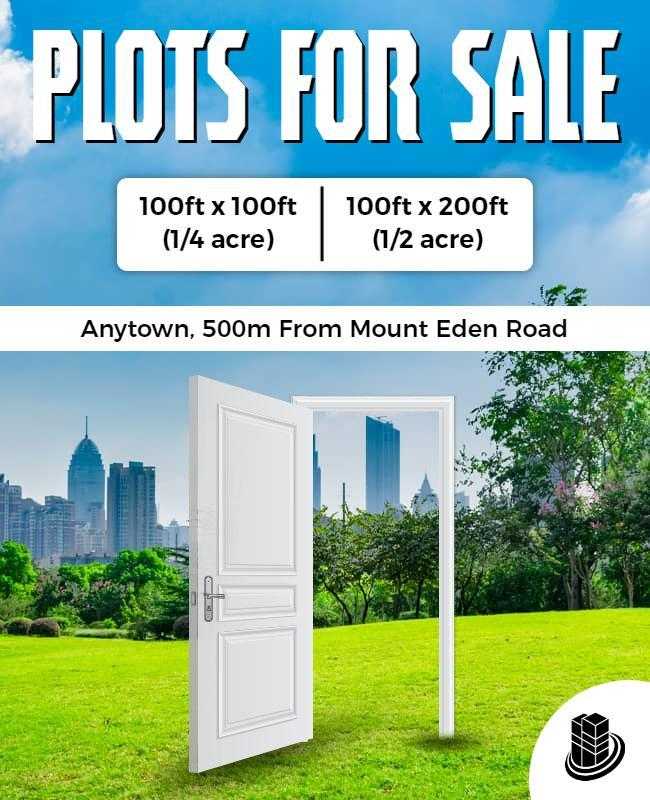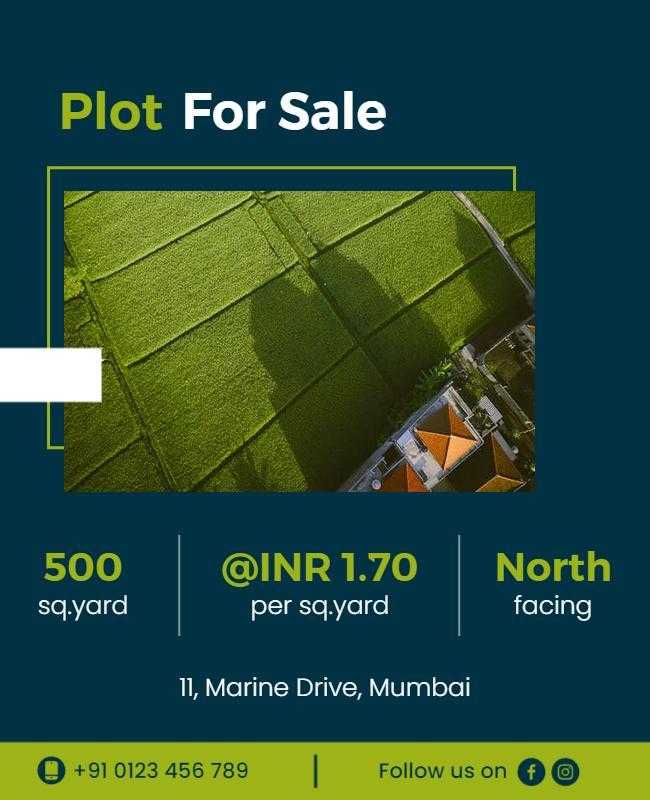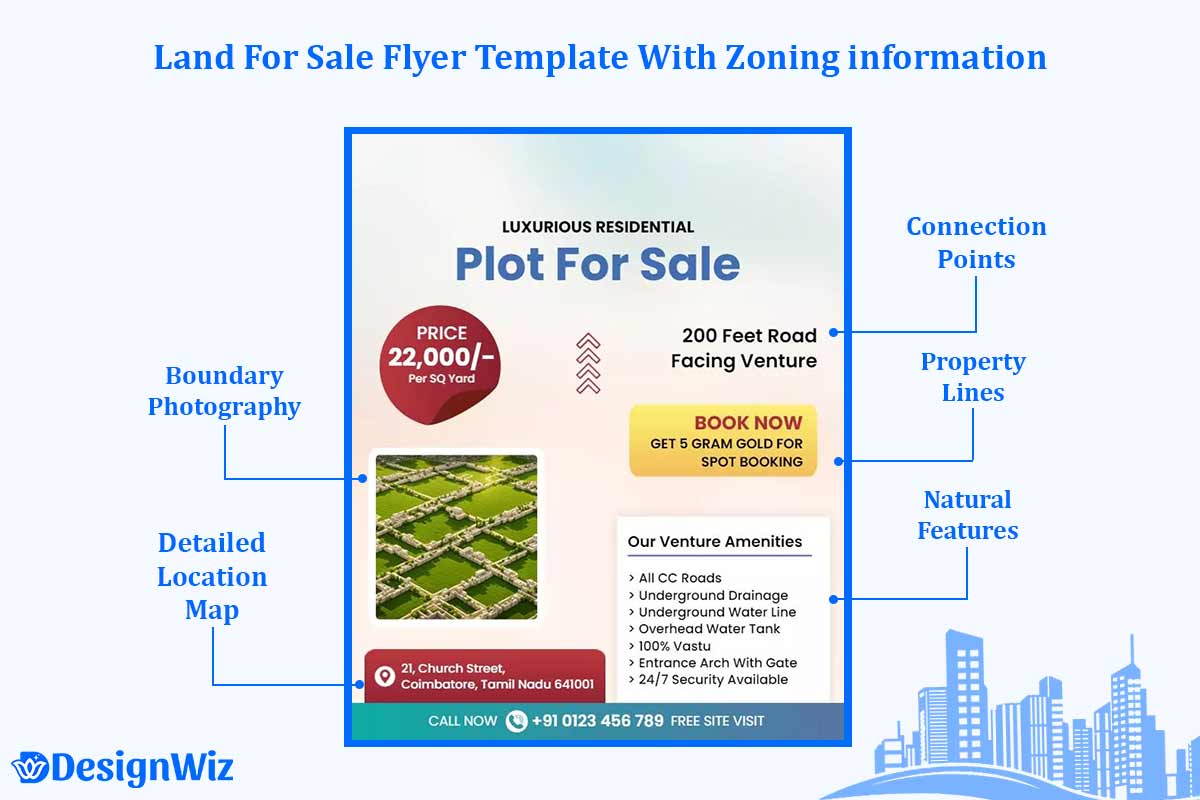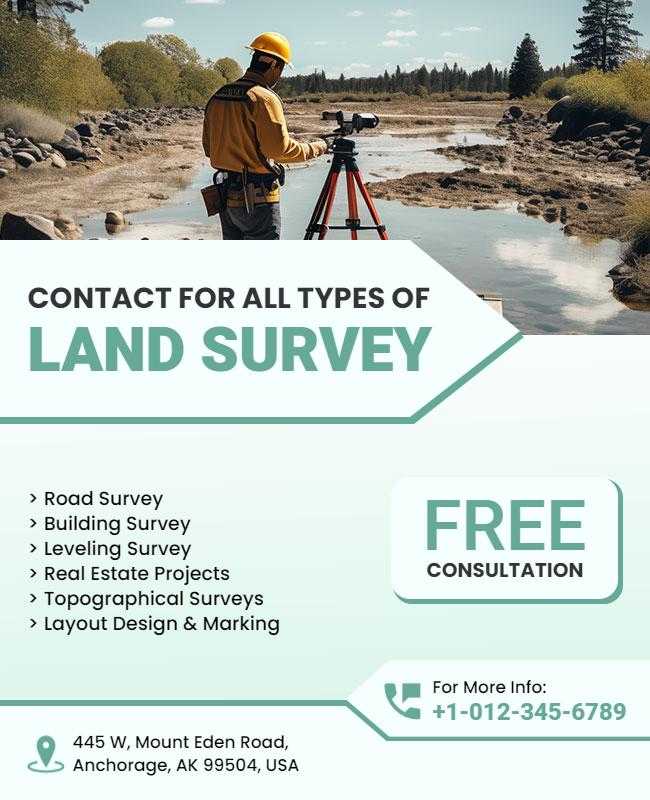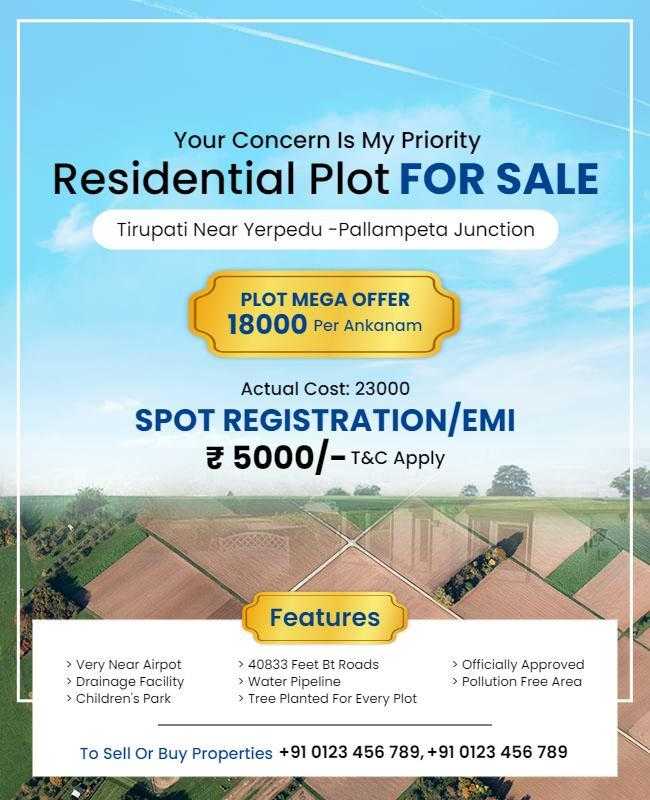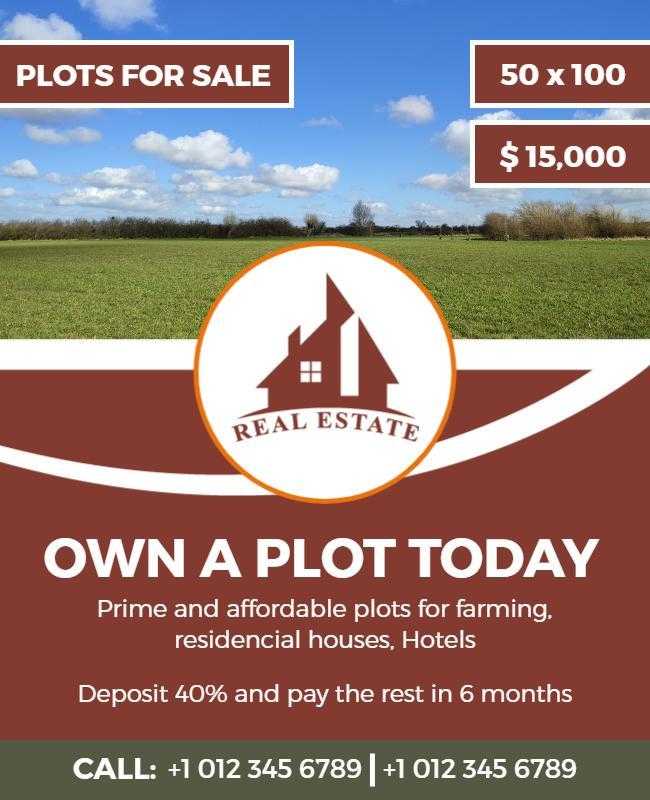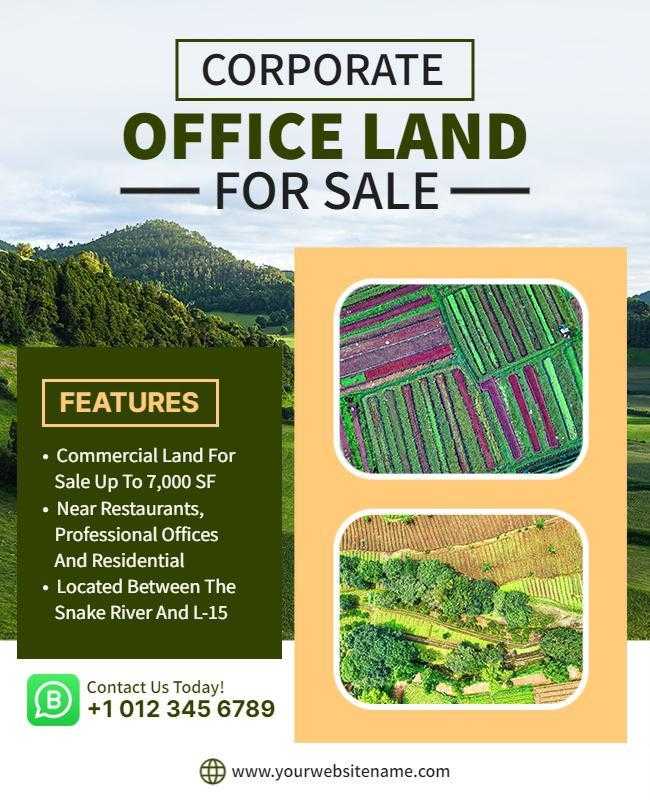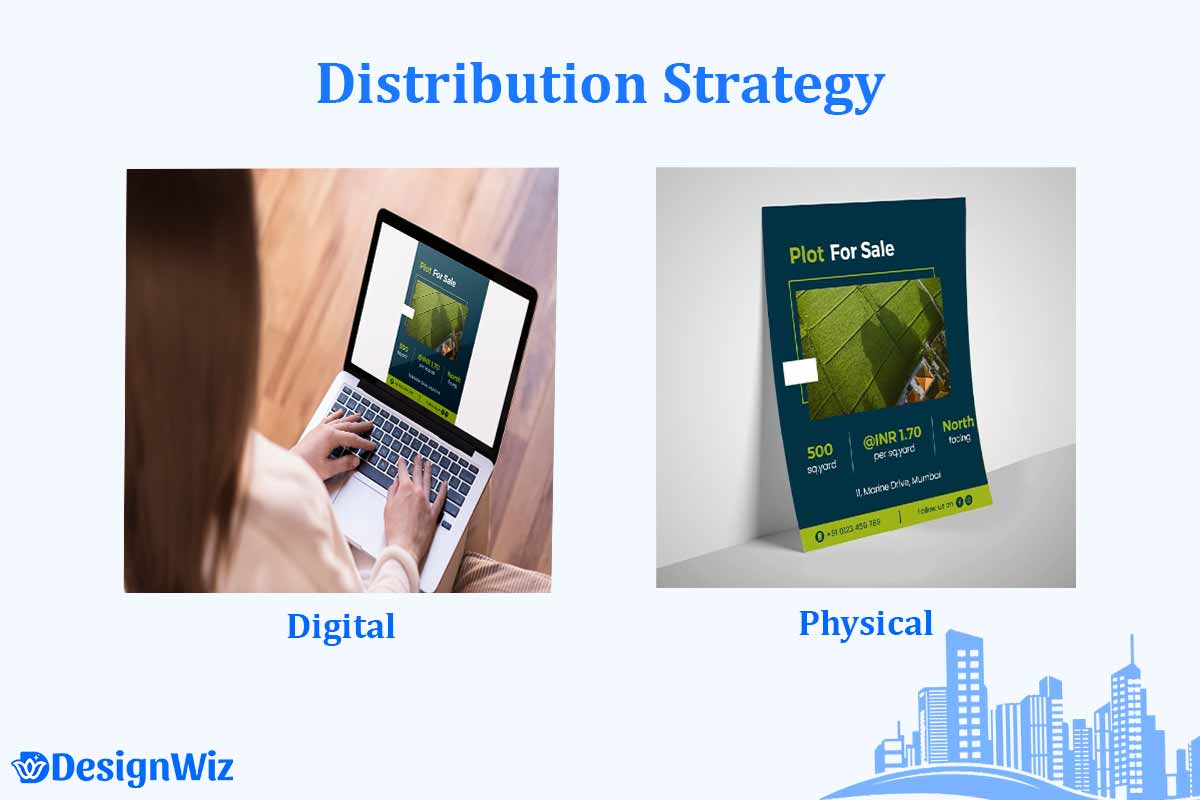Marketing land for sale requires a different approach than promoting residential homes. Vacant land flyers must highlight development potential, zoning perks, legal details, utility access, and boundary lines presented with visual appeal. Unlike homebuyers, land buyers need technical information and clear specifications over lifestyle features.
Effective land flyers target specific audiences investors, developers, or individuals by focusing on location advantages and development possibilities. Combining print with digital tools like QR codes helps provide detailed surveys, zoning data, and studies, supporting the longer decision-making process typical in land deals.
This guide shares practical strategies for create flyers that attract serious buyers whether for residential lots, agricultural acreage, or commercial properties.
How Do You Create Effective Land for Sale Flyers?
Effective land-for-sale flyer requires six essential elements. These include clear property identification with legal descriptions, comprehensive zoning and development information, and complete utility access details. They should also feature accurate measurements and boundary data, compelling development potential highlights, and professional visual representation through aerial photography, maps, and surveys.
Land vs Residential Marketing Differences
Land marketing fundamentally differs from residential property promotion in information hierarchy, visual requirements, and buyer expectations. While residential flyers emphasize lifestyle benefits and move-in readiness, land flyers prioritize development potential, investment returns, and technical specifications.
Essential information hierarchy places property specifications first. These include total acreage or square footage, zoning classifications with permitted uses, utility availability and connection costs, road access and easement information, environmental restrictions and considerations, and comprehensive survey data with boundary descriptions. This technical foundation differs significantly from residential marketing, where emotional appeals and lifestyle features dominate initial presentation.
Visual requirements emphasize documentation over lifestyle imagery. Professional land flyers require aerial photography showing property boundaries and context. They should also include topographical maps indicating elevation and natural features. They should also include location maps demonstrating proximity to infrastructure and amenities. Survey plats with accurate boundary identification are important as well. Additionally, utility maps should show service availability and connection points.
Here’s a curated selection of flyer designs that highlight the key differences between land and residential property marketing.
Land for Sale Flyer Design
Professional land for sale flyer design balances comprehensive technical information with visual appeal to attract and inform qualified prospects. Effective design hierarchy places critical property identification prominently. It also incorporates visual elements that enhance understanding. Finally, it provides clear pathways for accessing additional information.
Design elements include professional photography showcasing property potential. They also feature clear typography to ensure technical information readability. Additionally, strategic color schemes can suggest stability and growth. They should also feature comprehensive contact information with multiple communication options. Integrated QR codes can link to detailed documentation, including surveys, zoning reports, and environmental studies.
Template selection depends on property type and target audience. Investment-focused designs emphasize financial projections and development timelines. Agricultural templates highlight farming capabilities and water access. Commercial designs focus on traffic counts, visibility, and business development opportunities.
According to the FHWA design guide for roadside displays, text should have high contrast, use simple sans-serif fonts, and have at least a 30:1 contrast ratio for readability at speed principles that align with effective land-for-sale flyer design, especially for outdoor display visibility.1
Here’s a curated selection of land for sale flyer designs to help you present property details with clarity and professionalism.
Template Selection for Different Land Types
Choose templates based on property characteristics and target buyer profiles. Residential lot templates emphasize neighborhood context, building potential, and lifestyle considerations relevant to custom home construction. Agricultural land templates highlight farming capabilities, water rights, soil quality, and recreational opportunities appealing to farmers and rural lifestyle seekers.
Commercial and industrial templates focus on business development potential, emphasizing location advantages, zoning benefits, infrastructure access, and demographic information supporting business success. Investment templates include financial projections, comparable sales analysis, development cost estimates, and projected return calculations appealing to developers and investors.
Template customization accommodates specific property features. Waterfront properties emphasize water access and recreational potential, while mineral rights properties highlight extraction possibilities and royalty potential. Subdivision-ready properties emphasize development approval status and infrastructure planning, and conservation properties stress environmental benefits and tax advantages.
Get a range of flyer templates designed to suit specific land types—from residential and agricultural to commercial and industrial.
Read More: Real Estate Marketing Flyers: The Complete 2025 Guide to Every Flyer Type
How Do Land Sale Flyers Differ from Residential Property Marketing?
Land sale flyers prioritize technical information over emotional appeals, emphasizing development potential and investment opportunity rather than lifestyle benefits and move-in readiness. This fundamental difference requires a completely different information architecture, visual presentation, and marketing messaging.
Information Hierarchy Differences
Land flyers lead with property specifications: precise acreage measurements, zoning classifications, and development restrictions. Residential flyers prioritize bedrooms, bathrooms, and lifestyle amenities.
Essential land information includes zoning classifications with specific permitted uses. It also covers building restrictions, such as height limits and setback requirements, along with environmental considerations affecting development. It also covers utility availability and connection requirements.
Additionally, it includes road access status and maintenance responsibilities, as well as comprehensive survey data with monument locations and boundary descriptions. This technical data appears prominently in land marketing, unlike residential flyers, where such information typically appears in fine print or secondary documentation.
Timeline considerations differ significantly. Land marketing addresses longer evaluation periods, extended financing processes, and complex due diligence requirements. Marketing materials must support buyer research extending three to six months, compared to residential decisions often made within weeks.
Visual Element Priorities
Land marketing requires maps, surveys, and aerial photography rather than interior staging photos and lifestyle imagery. Successful land flyers include precise boundary identification with professional surveying. They should also provide comprehensive topographical context showing elevation changes and natural features. In addition, aerial perspectives can demonstrate land use patterns and development context. Detailed location maps indicating proximity to amenities and infrastructure are equally important. Utility maps showing service availability and connection points should also be included.
Professional photography focuses on development potential rather than current aesthetics. Aerial shots capture property scale and context. Boundary photography documents access points and property lines. Environmental photography highlights natural features and constraints. Infrastructure photography shows utility access and road conditions.
According to permitting guidelines from the City of Bellevue, professional boundary and topographic surveys provide essential data for clearly identifying land parcels, a crucial element in visual marketing materials for land listings (Bellevue, WA Development Permits, 2024).2
Target Audience Messaging
Land flyers target sophisticated buyers, including real estate investors seeking development opportunities and builders or developers requiring sites for specific projects. They also appeal to agricultural operators who are evaluating farming potential and individual buyers who are planning custom construction. Each audience requires specialized messaging emphasizing different property aspects.
Investor messaging emphasizes financial returns, development potential, market timing, and exit strategies. Builder messaging focuses on construction feasibility, permit processes, utility access, and project timelines. Agricultural messaging highlights farming capabilities, water rights, soil quality, and operational considerations. Individual buyer messaging addresses custom building opportunities, financing options, and lifestyle potential while maintaining technical accuracy.
What Information Must Be Included in Land for Sale Flyers?
Land for sale flyers must include comprehensive legal and zoning information, complete utilities and access details, and accurate size and boundary data to meet buyer due diligence requirements, support financing applications, and comply with real estate disclosure obligations.
Legal and Zoning Information
Zoning classifications determine permitted uses and development restrictions, making this information critical for buyer evaluation. Include specific zoning designations, such as R-1 Single Family, C-2 Commercial, or M-1 Manufacturing. Provide complete lists of permitted uses under current zoning, along with building height and density restrictions affecting development potential. Also include setback requirements from property lines and easements, as well as variance or rezoning possibilities with application processes and approval probabilities.
Environmental considerations require comprehensive disclosure, including wetland designations and restrictions. They should also cover flood zone classifications and insurance requirements, as well as soil conditions affecting building, such as percolation test results. Additionally, include environmental restrictions from conservation easements or habitat protection, and any contamination issues or remediation requirements affecting development.
Legal descriptions must include accurate property boundaries referenced to recorded surveys. They should also provide detailed easement information affecting property use, along with any encumbrances or liens affecting clear title. Additionally, note any homeowner association restrictions where applicable, and include mineral rights status with details on severance and extraction rights.
Pierce County zoning regulations define permitted and accessory uses such as residential, agricultural, and livestock structures as well as height limits, density rules, and setbacks, illustrating how legal constraints influence what can be marketed in land for sale flyer designs.3
Plot for Sale Poster
Plot for sale poster design requires specialized approaches for smaller residential parcels, emphasizing neighborhood integration and building potential over large-scale development opportunities. Effective plot marketing focuses on single-family residential development, architectural compatibility with surrounding properties, utility connection convenience, and community amenities access.
Design elements for plot marketing include neighborhood context photography showing surrounding development and architectural style examples compatible with local character. They should also feature utility connection diagrams illustrating ease of service hookup and community amenity maps highlighting schools, parks, and services. Additionally, include comparable sales data supporting valuation and market positioning
Here’s a set of plot for sale poster templates built for clear communication of size, pricing, access, and location everything a serious buyer needs to know.
Utilities and Access Details
Utility availability significantly impacts land value and development costs, requiring detailed documentation of service access and connection requirements. Document water service availability, including municipal versus well water options. Note connection costs and capacity requirements, as well as sewer access or septic system requirements with soil suitability testing. Also include electrical service proximity and transformer capacity, natural gas availability where applicable, and telecommunications infrastructure such as fiber optic and cellular coverage.
Road access information includes public versus private road access rights. It should also cover maintenance responsibilities for private roads and shared driveways, as well as easement requirements for landlocked properties. Additionally, note the distance to main thoroughfares, traffic patterns, and emergency service access compliance with local requirements. Include estimated utility connection costs and infrastructure development requirements for comprehensive buyer planning.
Size, Boundaries, and Survey Data
Accurate property measurements prevent legal complications and buyer disappointments during due diligence and closing processes. Include precise acreage or square footage calculations. Add detailed lot dimensions, including irregular boundary descriptions, along with comprehensive survey information with permanent monument locations. Also note topographical features affecting building placement and drainage, as well as GPS coordinates for easy property location and digital mapping integration.
Boundary descriptions must reference recorded surveys with the date and surveyor identification. They should identify all property corners with monument types and conditions and describe all easements or right-of-way areas affecting property use. Additionally, clarify any boundary disputes or unclear boundary areas, and provide legal descriptions matching deed records and title documentation.
According to the Texas Real Estate Research Center, boundary and land-title surveys such as Category 1A land title surveys provide precise measurements of parcel size, boundary lines, easements, and topography, and are commonly required for land transactions and title insurance, highlighting their fundamental role.4
Read More: Turn Property Views into Sales with Real Estate Flyers
How Should Land Flyers Vary by Property Type and Size?
Land flyers must adapt comprehensively to property type, size, and target audience. Residential lots should emphasize neighborhood development potential, while large acreage highlights multiple use opportunities and subdivision possibilities. Commercial land can focus on business development advantages and investment returns.
Small Residential Lots and Building Plots
Residential building lots require neighborhood context and single-family development focus, appealing to custom home builders and individual families planning construction. Include comparable home sales in the immediate area with pricing trends and market analysis. Also note neighborhood amenities such as schools, parks, and community services. Provide building timeline estimates and permit process information, along with any architectural restrictions or homeowner association requirements affecting design choices.
Marketing messages emphasize custom home building opportunities with architectural freedom and established neighborhood character supporting property value appreciation. They also highlight utility availability and convenient connection processes, as well as proximity to employment centers and lifestyle amenities. Additionally, note lot characteristics that support quality home construction, including drainage, orientation, and natural features.
Builder targeting includes specific information about local permit processes and approval timelines. It should also cover utility hookup procedures and cost estimates, along with neighborhood building standards and architectural review requirements. Additionally, include details on soil conditions and foundation requirements, as well as local contractor availability and construction cost factors.
Land for Sale Template
Land for sale template design accommodates diverse property types while maintaining professional presentation and comprehensive information delivery. Effective templates provide flexible layouts supporting various property characteristics, scalable design elements accommodating different acreage sizes, professional color schemes suggesting stability and growth potential, and integrated spaces for technical documentation including surveys and zoning information.
Template categories include residential development templates emphasizing neighborhood context and building potential. Agricultural templates highlight farming capabilities and rural lifestyle benefits, while commercial templates focus on business development and investment returns. Industrial templates emphasize logistics and manufacturing advantages.
These land for sale templates are built to showcase key details like acreage, boundaries, and location perfect for attracting serious buyers and investors.
Large Acreage and Agricultural Land
Large acreage properties require different marketing approaches emphasizing multiple use potential, subdivision possibilities, and agricultural capabilities. Include subdivision potential under current zoning with development cost estimates and approval processes, agricultural use capabilities including soil quality assessments and crop suitability analysis, recreational opportunities including hunting, fishing, and outdoor activity potential, and mineral rights and water rights information affecting long-term value and income potential.
Investment analysis includes comparable acreage sales with price-per-acre trends. It should also cover development timeline estimates and infrastructure cost projections. Additionally, include potential return on investment through development, agricultural use, or conservation programs, along with market timing analysis considering local development pressures and zoning changes.
Here’s a curated selection of flyer templates designed specifically for large acreage and agricultural land listings.
Commercial and Industrial Land
Commercial land marketing focuses on business development potential, investment returns, and location advantages supporting business success. Include comprehensive traffic count data and visibility analysis from major thoroughfares, detailed zoning benefits for business development, including permitted uses and expansion possibilities, infrastructure access and expansion capabilities, including utilities, transportation, and communications, and demographic information supporting business success, including population growth, income levels, and commercial activity trends.
Financial projections include development costs and potential returns with market-based assumptions, comparable commercial land sales with price per square foot analysis, market timing analysis considering economic conditions and development trends, and location advantages including accessibility, visibility, and growth potential within the regional business community.
Promote your commercial or industrial land with flyer designs tailored to highlight location benefits, utility access, and business development potential.
How Do You Effectively Market and Distribute Land Sale Flyers?
Effective land marketing requires targeted distribution to qualified prospects including investors, developers, and builders through industry-specific channels, specialized digital platforms, and geographic targeting strategies that reach decision-makers actively seeking development opportunities.
Target Audience Identification
Land marketing targets sophisticated buyer segments including real estate investors seeking development opportunities with specific return requirements, builders and developers requiring sites for planned projects with particular specifications, agricultural operators evaluating farming potential and operational capabilities, and individual buyers planning custom construction with lifestyle and budget considerations.
Investor targeting emphasizes financial returns, development potential, market timing, and exit strategies. Messaging includes projected returns, development timelines, market analysis, and risk assessment. Builder targeting focuses on construction feasibility, permit processes, utility access, and project timelines. Agricultural targeting highlights farming capabilities, water rights, soil quality, and operational infrastructure.
Open Plots Creative Ads
Open plots creative ads require innovative approaches highlighting development potential and investment opportunities for residential subdivision or commercial development. Creative advertising emphasizes visual storytelling, financial opportunity presentation, and lifestyle enhancement possibilities all of which can be effectively captured in a professionally designed plot flyer.
Design strategies include before-and-after development renderings showing potential outcomes, lifestyle imagery suggesting community development possibilities, investment infographics highlighting financial opportunities, and interactive elements including QR codes linking to detailed development studies and financial projections.
Distribution Channel Strategy
Professional land marketing utilizes industry publications reaching development professionals, specialized real estate investor networks and associations, development association meetings and conferences, and commercial real estate brokerage networks. Digital distribution includes specialized land listing websites with advanced search capabilities, social media targeting to development professionals and investors, email campaigns to qualified prospect databases, and online advertising targeting specific buyer demographics.
Geographic targeting reaches local, regional, and national investors depending on property characteristics and development potential. High-value development properties with significant potential attract national attention, while smaller residential lots and agricultural properties primarily interest local and regional buyers.
Digital Integration Approach
Modern land marketing integrates digital and print materials through QR codes linking to comprehensive property documentation, virtual tour capabilities showing aerial perspectives and boundary identification, downloadable documents including surveys, zoning reports, and environmental studies, and interactive maps providing detailed property context and infrastructure information.
What Legal and Compliance Issues Should Be Addressed in Land Flyers?
Land marketing materials must address comprehensive disclosure requirements, truth in advertising standards, and professional verification obligations to protect both sellers and buyers while complying with real estate regulations and industry standards.
Required Disclosure Elements
Environmental disclosures include detailed flood zone designations and insurance requirements, wetland restrictions and development limitations, soil conditions affecting building including engineering requirements, hazardous material considerations and remediation obligations, and conservation restrictions from easements or environmental protection programs.
Zoning disclosures must accurately represent current permitted uses without overstating development potential, clearly identify building restrictions including height, density, and setback limitations, disclose any pending zoning changes or variance applications affecting property use, and provide realistic timelines for development approval processes including potential obstacles and costs.
Utility limitations require disclosure of actual connection availability with cost estimates, capacity restrictions affecting development scale, any restrictions on utility access from easement limitations, and infrastructure development requirements for full utility service including road improvements and utility extensions.
Federal law mandates that sellers and agents of homes built before 1978 must provide buyers with an EPA-approved pamphlet (“Protect Your Family From Lead in Your Home”), disclose any known lead-based paint hazards, include a lead warning statement in the contract, and offer a 10-day opportunity for inspection or risk assessment before sale or lease execution.5
Land for Sale Advertisement Sample
Land for sale advertisement samples demonstrate proper disclosure integration while maintaining marketing effectiveness and buyer appeal. Effective samples balance comprehensive information with visual appeal, include all required legal disclosures without overwhelming design, and provide clear contact information and next steps for interested prospects.
Sample elements include professional photography with accurate property representation, complete property specifications with surveyed measurements, comprehensive zoning and utility information with realistic development potential, appropriate disclaimers encouraging professional consultation, and clear contact information with multiple communication options.
Truth in Advertising Standards
Marketing materials must accurately represent development potential without promising outcomes dependent on uncertain approvals or market conditions. Avoid statements about guaranteed returns, definitive development timelines, or assured approval processes without proper substantiation from professional studies and local authority confirmation.
Professional verification includes survey confirmation with licensed surveyor certification, zoning verification with local planning authorities, utility availability confirmation with service providers, environmental assessment with appropriate professional consultation, and legal review ensuring compliance with disclosure requirements and industry standards.
Professional Consultation Recommendations
Land transactions benefit from professional guidance, including licensed surveyor verification of boundaries and measurements, attorney review of legal descriptions and title issues, environmental consultant assessment of development constraints and regulatory compliance, civil engineer evaluation of building feasibility and infrastructure requirements, and financial advisor analysis of investment potential and financing options.
Read More: The Complete Real Estate Agent Flyer Guide: 2025 Design Strategies That Convert
FAQs About Land for Sale Flyer
Zoning information with permitted uses, accurate property boundaries with survey data, utility availability with connection costs, and access details with road maintenance responsibilities are essential for qualified buyer evaluation. Include comprehensive legal descriptions, development restrictions, and environmental considerations to prevent misunderstandings and support serious inquiries from qualified prospects.
Present development potential realistically with appropriate disclaimers about approval requirements and market conditions. Include current zoning permits and restrictions, building limitations and setback requirements, environmental constraints and mitigation requirements, and infrastructure development needs with cost estimates. Avoid guaranteeing development outcomes while clearly highlighting genuine opportunities supported by professional analysis.
Aerial photography showing accurate property boundaries and surrounding context, detailed topographical maps indicating elevation changes and natural features, comprehensive location context within the community and region, access road views demonstrating property accessibility, and survey plats with monument identification provide essential visual information supporting buyer evaluation and due diligence.
Investor marketing emphasizes financial returns with detailed projections, development timelines with realistic approval processes, comprehensive market analysis with comparable sales data, and risk assessment with mitigation strategies. Individual buyer marketing focuses on custom building opportunities with lifestyle benefits, neighborhood character and amenity access, financing options and construction timelines, and lifestyle potential while maintaining technical accuracy and realistic expectations.
Disclose all known environmental restrictions and development limitations, zoning constraints and building requirements, utility availability and connection obligations, access limitations and easement restrictions, and any title issues or encumbrances affecting property use. Include accurate legal descriptions matching deed records, comprehensive survey information with monument identification, and appropriate disclaimers encouraging professional consultation for development planning and legal review.
Clearly state actual utility availability status with verification sources, document connection requirements and estimated costs with service provider confirmation, disclose access limitations including easement requirements and road maintenance obligations, reveal infrastructure development needs with engineering estimates, and provide realistic cost projections while encouraging buyer verification through utility companies, municipal authorities, and professional consultants.
People Also Ask About Land for Sale Marketing
What size should land for sale flyers be?
Standard 8.5 x 11 inch flyers work well for most land marketing applications, while 11 x 17 inch formats better accommodate larger maps, surveys, and complex property documentation for substantial development properties.
How much does it cost to create land sale marketing materials?
Professional land or sale flyer design costs $200-500 depending on complexity and customization requirements, while template-based designs cost $50-150 for professional customization, printing, and distribution.
What photos should be included on land flyers?
Aerial photography showing property boundaries and context, detailed boundary maps with survey accuracy, access road views demonstrating property accessibility, and surrounding area context photos providing development and location perspective.
Do land for sale flyers need different information than house flyers?
Yes, land flyers emphasize zoning classifications, utility availability, development potential, and legal descriptions rather than interior features, lifestyle amenities, and move-in readiness typical of residential marketing.
How do you price vacant land for marketing materials?
Land pricing considers comparable sales analysis, development potential assessment, zoning benefits evaluation, and infrastructure access costs rather than cost-per-square-foot residential calculations or improvement values.
What are the best colors for land sale flyers?
Professional blues and greens suggest reliability, growth, and environmental harmony, while earth tones connect with land development themes and natural characteristics appealing to buyers.
Should land flyers include development renderings?
Development renderings help buyers visualize potential outcomes but must include clear disclaimers about conceptual nature, approval requirements, and dependence on various factors beyond seller control.
How long should you market land before reducing the price?
Land typically requires 6-12 months of active marketing before price adjustments, significantly longer than residential property due to specialized buyer pool and extended due diligence requirements.
Conclusion
Successful land marketing requires comprehensive information presentation, professional visual design, and targeted distribution to qualified prospects actively seeking development opportunities. Focus on technical accuracy, realistic development potential communication, and comprehensive legal disclosures to attract serious buyers and facilitate smooth transactions while building reputation for professional integrity.
Implement specialized marketing approaches for different property types: residential lots emphasizing neighborhood context and custom building potential, large acreage highlighting multiple use opportunities and investment potential, and commercial land focusing on business development advantages and financial returns. Adapt messaging, visual elements, and technical detail levels to match target audience sophistication and specific property evaluation criteria.
Professional flyer templates provide structured frameworks for essential information presentation while maintaining visual appeal and credibility with sophisticated buyers. Land for sale Templates ensure consistent information delivery, professional presentation standards, and compliance with disclosure requirements while allowing customization for specific property characteristics and target audiences.
Coordinate marketing efforts with qualified professionals including real estate attorneys, licensed surveyors, environmental consultants, and development specialists to ensure accurate representation and successful marketing outcomes. Professional guidance protects both buyers and sellers while enhancing marketing credibility and transaction success rates.
Reference
- “Design Guide for Roadside Displays (G‑6).” Federal Highway Administration. (2023). Retrieved June 27, 2025
- “Boundary & Topographic Survey Requirements.” City of Bellevue, WA.
- “What Is Allowed in a Zone?” Pierce County (WA).
- “Sizing Up Surveys.” Texas Real Estate Research Center (Texas A&M University). Rusty Adams.
- “Lead-Based Paint Disclosure Rule (Section 1018 of Title X).” U.S. Environmental Protection Agency. Last updated on January 23, 2025.


